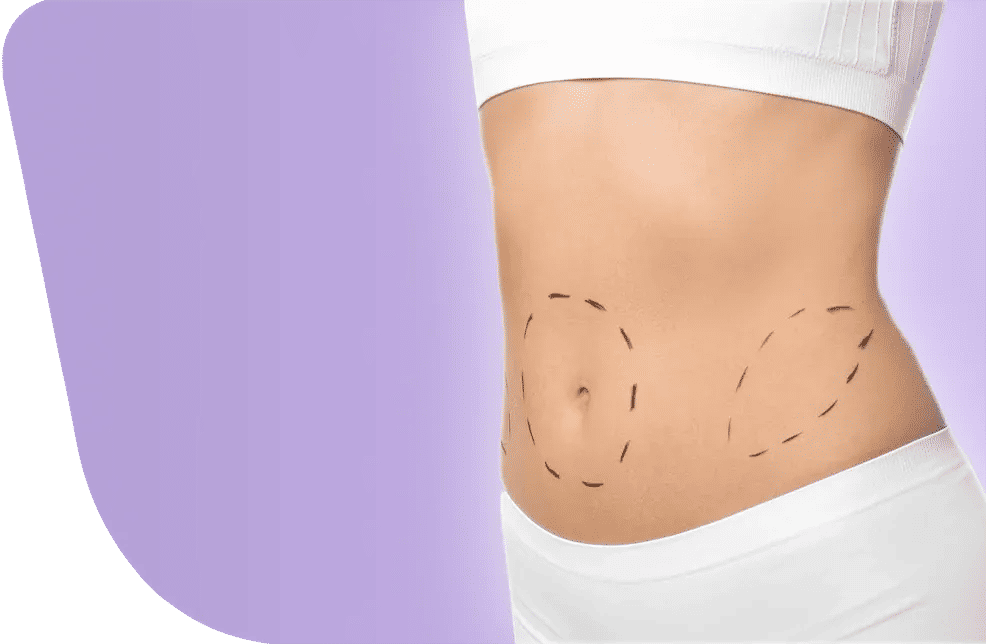- - What Is Abdominal Liposuction?
- - What is a Lumpy Stomach After Liposuction?
- - What are the Causes of a Lumpy Stomach After Liposuction?
- - Mistakes That Lead to a Lumpy Stomach After Liposuction
- - How to Smooth Out a Lumpy Stomach After Liposuction?
- - When to Be Concerned About a Lumpy Stomach After Liposuction?
- - Get a Smooth Recovery with Turkey Luxury Clinics
- - FAQs About Lumpy Stomach After Liposuction
Many patients expect a smooth, flat stomach after liposuction. However, it’s common to notice uneven or “lumpy” areas on the abdomen in the weeks following the procedure. A lumpy or bumpy stomach after liposuction is usually temporary and often caused by fluid accumulation, fibrosis, or uneven fat healing beneath the skin.
While this can be concerning, it’s generally not an abnormal complication. Still, understanding what causes a lumpy stomach after liposuction, how to manage it, and when to seek medical advice is essential for a safe recovery and smooth, lasting results.
What Is Abdominal Liposuction?
Abdominal liposuction is an aesthetic procedure performed to remove excess fat and enhance body contour. It can be done alone or combined with other plastic surgeries, such as ab etching or six-pack surgery. Even after ab etching liposuction, some patients may notice a lumpy stomach due to temporary swelling or tissue irregularities during the healing process.
What is a Lumpy Stomach After Liposuction?
A lumpy stomach after liposuction refers to the appearance of hard lumps and uneven, or bumpy areas under the skin. These may feel like small nodules or ridges, and it is a normal part of the healing process that may appear shortly after the procedure and resolve within weeks or months later.
What are the Causes of a Lumpy Stomach After Liposuction?
There are several causes that lead to the appearance of hard lumps after tummy liposuction. Most of these causes are part of healing, such as the fluid accumulation in seromas (fluid-filled sacs) or hematomas (blood collections). Other causes, like the formation of scar tissue (fibrosis), residual fat, and uneven skin texture as the body adjusts, are also possible.
1. Fluid accumulation (seroma)
After liposuction, fluid may sometimes collect beneath the skin, making the stomach appear uneven, swollen, tense, or distended.
Fluid accumulation after liposuction happens when the lymphatic system, the body’s natural drainage network, is temporarily disrupted during fat removal, causing fluid to pool in the treated area.
Unlike hard lumps caused by fibrosis or residual fat, fluid buildup produces a more bloated appearance; the area may feel soft or slightly mobile, which indicates the presence of liquid rather than solid tissue.
Most cases of fluid accumulation resolve naturally within 2 - 6 weeks as the body gradually reabsorbs the fluid, especially when patients wear compression garments regularly and use warm compresses as recommended by their surgeon.
2. Hematomas
A hematoma is a collection of blood under the skin that occurs when tiny blood vessels are temporarily damaged during liposuction; these collections can create irregular and hard lumps in the abdominal area.
These hematoma-related lumps after liposuction usually resolve on their own within a few days to a couple of weeks, depending on their size and location.
To minimize hematoma formation after liposuction, it is recommended to use compression garments immediately after surgery, and if a hematoma does form, its resolution can be accelerated by continuing to wear compression garments, gently massaging the area. In rare cases, a larger hematoma may require medical drainage.
3. Fibrosis
Fibrosis is one of the most common reasons for a hard, lumpy stomach after liposuction, especially when scar tissue forms unevenly during recovery.
Fibrosis usually appears as hard lumps or knots under the skin, with thickened or uneven texture (bumpy skin), persistent swelling, and sometimes localized discomfort.
These lumpy areas typically last from a few weeks up to six months, depending on the extent of tissue trauma during the liposuction and individual healing.
To reduce fibrosis, patients are advised to use manual lymphatic drainage massage, wear compression garments consistently, and follow their surgeon’s post-operative instructions regarding diet, activity, and overall care.
4. Residual Fat After Liposuction
A lumpy stomach can result from residual fat when some fat cells were not fully removed during liposuction. These remaining fat deposits in the treated area may enlarge if you gain weight, causing the abdomen to look uneven or lumpy.
In many cases, minor fatty lumps are absorbed by the body and become less noticeable over 2–3 months as swelling decreases and the tissues settle.
However, larger or persistent fat deposits may require additional procedures or touch-ups to achieve a fully smooth contour.
Following your surgeon’s post-operative instructions and maintaining a stable weight can help minimize the risk of uneven fat accumulation.
Mistakes That Lead to a Lumpy Stomach After Liposuction
A lumpy stomach after liposuction can result from mistakes made either during the procedure or during the recovery period.
Common errors include uneven fat removal, skipping compression garments, and returning to physical activity too soon.
Other factors, like avoiding lymphatic massages or neglecting proper wound care, can also lead to swelling, fluid buildup, and scarring that cause lumps.
1. Uneven or Incomplete Fat Removal:
If too much or too little fat is removed, or if the removal is done unevenly, it can create surface irregularities such as bumps, peaks, valleys, or indentations on the skin.
2. Excessive Tissue or Vessel Damage:
Removing fat too aggressively can injure nearby tissues or blood vessels, leading to complications such as hematomas and fibrosis, which may cause lumps or irregularities in the abdominal area.
3. Not Wearing Compression Garments:
Compression garments are essential for recovery. They help the skin retract smoothly, reduce swelling, and prevent fluid accumulation or the formation of lumps.
4. Returning to Physical Activity Too Soon:
Exercising before the body has fully healed can cause inflammation and fluid retention, leading to swelling, bruising, and uneven skin texture.
5. Skipping Lymphatic Massages:
Lymphatic drainage massages help the body eliminate excess fluid and prevent fibrosis. Skipping them can result in prolonged seromas, hematomas, or persistent swelling and lumps.
6. Poor Wound Care:
Failing to keep incision sites clean and protected can lead to infections, delayed healing, and fibrosis, reulting in uneven skin texture, nodules, or lump formation.
How to Smooth Out a Lumpy Stomach After Liposuction?
After liposuction, achieving a smooth and even abdominal contour takes time, patience, and proper care. Here are the most effective methods to get rid of stomach lumps after liposuction:
1. Wear a Compression Garment
Wearing compression garments after liposuction minimizes the space created between skin and stomach where fat is removed, helping in reducing swelling and supporting proper contouring. Consistently wear them as recommended by your surgeon, especially during the first 2–6 weeks. It is one of the most important steps for a smooth recovery and a flat abdomen.
2. Maintain a Healthy Diet and Stay Hydrated
During liposuction recovery, eating a balanced diet rich in protein, vitamins, and minerals supports tissue healing. Limiting salty foods can help minimize fluid retention. Staying well-hydrated supports skin elasticity and overall recovery, reducing the risk of lumps and unevenness.
3. Massage Therapy
Gentle massage after liposuction is an effective and widely recommended method to prevent or smooth out a lumpy stomach. It can be performed through different techniques, such as manual lymphatic drainage or traditional soft-tissue massage, depending on the patient’s recovery stage.
Using your fingers or a soft brush, gently massage the treated area in circular motions for about 10 minutes daily. Applying a warm compress or heating pad beforehand helps soften the tissues, making the massage more effective.
Massage therapy after liposuction promotes lymphatic drainage, reduces swelling, softens fibrous tissue, and improves blood circulation — all of which help smooth the skin and reduce the appearance of lumps during recovery.
4. Moderate Exercise
Engaging in gentle movement, such as walking, helps promote blood circulation and lymphatic drainage, which can reduce swelling and prevent fluid or tissue from hardening into lumps.
Avoid strenuous activity during the first few weeks, as advised by your surgeon, to ensure proper healing and maintain a smooth abdominal contour.
When to Be Concerned About a Lumpy Stomach After Liposuction?
You should always contact your surgeon if you notice any of the following:
- The lumps are accompanied by signs of infection, such as a fever, redness, or warmth in the treated area.
- The lumps are causing severe or persistent pain, which is not typical of normal post-operative recovery.
- Significant lumps or unevenness remain beyond the expected healing period, usually around 3–4 months.
- The lumps are rapidly growing, unusually hard, or changing in shape, which may signal complications that need to be evaluated.
Get a Smooth Recovery with Turkey Luxury Clinics
If you’re planning liposuction or want to enhance the results of a previous procedure, book your consultation with Turkey Luxury Clinics today. Benefit from the expertise of top surgeons and the latest techniques for safe, effective, and smooth results.
Achieve a flat, even stomach and beautifully contoured body—schedule your personalized consultation now.
Liposuction is not a weight-loss procedure, although it can sometimes lead to loose skin — just like what happens after significant weight loss. If you are concerned about sagging skin, you may find these helpful:
How to avoid loose skin after weight loss
How to tighten skin even by natural ways, and the best skin tightening treatments












.webp)
.webp)
.webp)
.webp)

